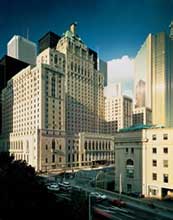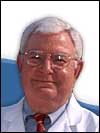Notes from the 24th Annual Meeting of the International Tinnitus Forum
By Barry Keate
Barry Keate, has lived with tinnitus over 40 years and has published 150+ research articles on numerous aspects of tinnitus. He is an expert on the condition and a well-known advocate for those with tinnitus.
 The International Tinnitus Forum (ITF) held its annual meeting September 16th at the Fairmont Royal York Hotel in Toronto, Ontario. The Royal York is at the foot of the Toronto Canada National (CN) Tower, the tallest building in the world at 1,815 feet. The meeting provided important information on new therapies and techniques for preventing and treating tinnitus as well as further discussion of existing treatments. It was very encouraging to see how much research is being invested in the causes of and treatments for tinnitus.
The International Tinnitus Forum (ITF) held its annual meeting September 16th at the Fairmont Royal York Hotel in Toronto, Ontario. The Royal York is at the foot of the Toronto Canada National (CN) Tower, the tallest building in the world at 1,815 feet. The meeting provided important information on new therapies and techniques for preventing and treating tinnitus as well as further discussion of existing treatments. It was very encouraging to see how much research is being invested in the causes of and treatments for tinnitus.
 The ITF is an annual meeting of eminent researchers and scientists concerned with furthering advances in the prevention and treatment of tinnitus. It is hosted by the Martha Entenmann Tinnitus Research Center and State University, New York (SUNY). The Program Chair is Abraham Shulman, MD, Professor Emeritus of Otolaryngology at SUNY, and the Program Coordinator is Barbara Goldstein, PhD, the Director of Audiological Research. Michael Seidman, MD is the Co-Moderator of the Forum and the Senior Editor of the International Tinnitus Journal, which publishes papers presented at the Forum.
The ITF is an annual meeting of eminent researchers and scientists concerned with furthering advances in the prevention and treatment of tinnitus. It is hosted by the Martha Entenmann Tinnitus Research Center and State University, New York (SUNY). The Program Chair is Abraham Shulman, MD, Professor Emeritus of Otolaryngology at SUNY, and the Program Coordinator is Barbara Goldstein, PhD, the Director of Audiological Research. Michael Seidman, MD is the Co-Moderator of the Forum and the Senior Editor of the International Tinnitus Journal, which publishes papers presented at the Forum.
This article offers a brief overview of the presentations.
1 – Abraham Shulman, MD, Martha Entenmann Tinnitus Center
Dr. Shulman is interested in the basic science of tinnitus. He has been developing methods to objectively determine the severity of tinnitus since 1979. In prior research, he has determined the final common pathway of tinnitus relates to the GABA receptors in the brain and has developed a pharmacological approach to treatment.
In this presentation he described Tinnitus Desynchronize/Synchronize Theory (TDST). This is a lack of timing or phase-shift of the auditory signal as it communicates between the cochlea and the auditory cortex. He described the oscillations of normal brain waves, some of which are generated by the auditory cortex and others generated by the cochlea. If these oscillations are not synchronous, that is of the same wavelength and phase, there is a discontinuity of communication between the two areas of the brain.
Synchronized oscillations of broad frequency brain waves are necessary for learning, memory, hearing and all brain related functions.
Dr. Shulman is convinced the desynchronous behavior of the brainwaves of tinnitus patients is related to the excitatory vs. inhibitory neural functions that are controlled by the GABA receptors. Measuring brain wave dysynchrony provides an objective way to analyze tinnitus severity.
In clinical practice, Dr. Shulman begins treatment with Neurontin and Klonopin. He states that 80-85% of patients achieve some degree of relief. He also uses tinnitus maskers and Tinnitus Retraining Therapy (TRT). TRT is used primarily for those patients with hyperacusis, a condition of extreme sensitivity to sound.
2 – Paul van de Heyning, MD, Holland
Dr. van de Heyning’s presentation was on Cochlear Implantation with electrodes. This is an invasive treatment requiring surgical implantation of the electrodes and is usually only conducted on those with severe hearing loss and tinnitus. It can restore a degree of hearing and reduce tinnitus sounds for most patients.
In a small clinical study, conducted in Holland, 20 patients were implanted with electrodes. All had a positive response regarding their tinnitus. On a scale of 1 to 10, the mean tinnitus was at 8.5 prior to the implantation. After implantation, the mean tinnitus was 2.5.
Dr. van de Heyning’s clinic also uses Tinnitus Phase-out System™, a sound-based phase-shift system developed in the US. Tinnitus sound is matched for frequency and loudness, then played back out of phase with the tinnitus sound. This results in a reduction of the tinnitus for a period of time. More information on this therapy can be read below in this article.
After clinical treatments, provided they are successful, the patient is able to purchase a home system. This is used for 30 minute treatments daily. Their experience with this system is very limited and there are no clinical results as yet.
3 – Michael Hoffer, MD, Commander, United States Navy, Naval Medical Research Center
Dr. Hoffer did a follow-on presentation of his research into anti-oxidants and hearing loss. His initial presentation was given at last year’s ITF in Los Angeles.
He also presented some new data from the US Navy on the number of service members who suffer hearing loss and tinnitus. Over 25% of all returnee service members experience hearing loss and tinnitus. This number dramatically escalates to 90% of those who have experienced blast injuries. Over 30,000 service members per year file for Veterans Administration compensation for hearing loss and tinnitus.
Hearing loss is caused by oxidative stress. Impulse noise exposure, weapons fire and blast injuries can cause sudden onset hearing loss. This can be prevented or greatly reduced by using antioxidants.
Naval Medical Research Studies show that there is no benefit from anti-oxidants later than 8 hours following hearing loss damage. Dr. Hoffer stated he does not know the effect of anti-oxidants on tinnitus. The studies were conducted with hearing loss as the primary outcome, not tinnitus. The data is not valid for secondary outcomes and Dr. Hoffer would like more studies conducted with tinnitus as the primary outcome.
The anti-oxidants Dr. Hoffer is working with are N-Acetyl-Cysteine (NAC) and Acetyl-L-Carnitine.
 4 – Guest of Honor – John Emmett, MD, Shea Center for Ears, Memphis, TN
4 – Guest of Honor – John Emmett, MD, Shea Center for Ears, Memphis, TN
Dr. Emmett gave a presentation on the history of Lidocaine treatment for tinnitus. Dr. Emmett introduced Lidocaine treatment to the United States and has been working with it for many years.
Lidocaine is a short-term anti-convulsant. As Hippocrates stated in 400 BC, “Tinnitus is the little brother of epilepsy”. Dr. Emmett views tinnitus as an epileptic-like condition in the Central Nervous System.
It has been known since 1935 that Lidocaine can greatly relieve tinnitus. Unfortunately, it has a half-life of only 100 minutes. This means that half of the Lidocaine administered to the body will be metabolized in 100 minutes. Half of the remainder metabolizes in the next 100 minutes, and so on. In other words, the effectiveness of the medication wears off very quickly.
In a small clinical study of 54 tinnitus patients at the Shea Clinic, 43 patients, or 80%, had relief from their symptoms varying between 20% and 100% reduction. In this study, Lidocaine was administered by IV infusion and was followed by oral administration of Tegretol, an anti-convulsant medication with a half-life of 11 hours. The Tegretol showed significant side effects in 26% of patients.
Dr. Emmett then tried Lidocaine infusion with oral Tocainide, a similar medication but one that is not available in the US. There was a gradual trend toward relief with fewer side effects.
Dr. Emmett has also tried Lidocaine perfusion through the eardrum directly onto the cochlea along with oral Xanax taken twice daily. There has been some nausea, vomiting and dizziness with this technique. After one month 10% of patients had complete reduction, 60% had some reduction and 30% had no reduction. After one year the same patients had much less reduction than after one month.
To date, Dr. Emmett has not developed a standard therapy for tinnitus patients that shows consistently positive results. He presented this list, in descending order, of the treatments he uses.
1-First, he recommends Ginkgo biloba to his tinnitus patients. He states that the Europeans swear by it and he has seen positive results. (Note:Arches Tinnitus Relief Formula® contains pharmaceutical-quality Ginkgo biloba extract in a dosage of 480 mg daily). If this is ineffective, he then recommends:
2-Buspar, an anti-anxiety medication, then
3-Amitriptylene, an anti-depressant medication, then
4-Effexor, another anti-depressant medication.
If none of the above are helpful and the tinnitus is disabling, Dr. Emmett will then treat his patients with Lidocaine perfusion through the eardrum along with Dexamethasone, a steroid medication. This is an invasive procedure and only used in severe cases.
5 – There was a brief report on Benign Intercranial Hypertension (BIH) which can cause pulsatile tinnitus. BIH is elevated blood pressure in the brain. Most, but not all, of the patients are overweight. In some cases, Topamax, an anti-seizure medication, can lead to weight loss, lowered blood pressure and reduced tinnitus.
6 – Another brief report was on tinnitus that is not associated with hearing loss. It is usually considered that damage to inner hair cells causes hearing loss and tinnitus. The researchers have concluded that damage to the outer hair cells of the cochlea can cause tinnitus without hearing loss.
Sound Based Tinnitus Therapy
During the annual meeting of the Academy of Otolaryngology, which began after the ITF concluded, I had a chance to meet with Calvin Yee, the President of Tinnitus Control Inc. in New York City. In a previous issue we discussed the Tinnitus Phase-Out System™ offered by Tinnitus Control. This is the therapy where a patient’s tinnitus sound is matched for both frequency and loudness. These parameters are then programmed into a patient treatment device, which phase-shifts a matched signal played back to the patient for 30 minutes for each treatment. This results in a negation of the tinnitus sound and leads to Residual Inhibition where the tinnitus is reduced, or even abolished, for a period of time after the playback. Please see our article on sound based tinnitus therapy in our Tinnitus Library for details of the therapy and contact information.
Mr. Yee informed me that one of their recently-completed clinical trials is ready for publication and Tinnitus Control is developing relationships with clinics across the US to offer this therapy. He invited me to a presentation by Ruthann Lipman, DO and Sidney Lipman, MD from Erie, PA, about their results from a study conducted with the Phase-Out System.
In previous studies 83% and 70% of patients responded to this treatment with at least 6 dB reduction of tinnitus sound (6 dB equals 50% reduction of intensity). The Residual Inhibition lasted for varying, but undetermined, lengths of time before the tinnitus returned to its previous level.
During a single-blind, placebo-controlled study conducted by the clinic in Erie, 57% of 59 patients achieved at least 6 dB reduction in loudness and 42% had Residual Inhibition that lasted between one hour and seven days (average 2 days). Since the end of the study 40% of participants had purchased or expressed interest in purchasing the portable, home use device offered by Tinnitus Control.
Mr. Yee and I also discussed using Arches Tinnitus Formulas in conjunction with the Sound Based Tinnitus Therapy as a way to achieve even better results for those who suffer from tinnitus.
This therapy should be available in several clinics across the US by mid-2007. We will report on the progress of this therapy as we learn more.
